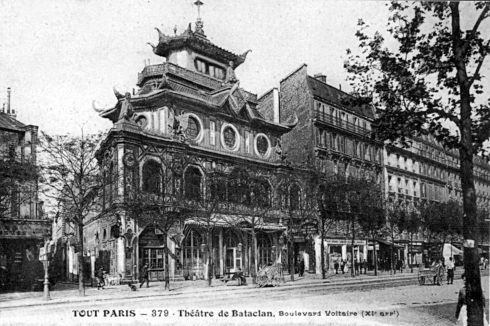|
Lupe Vélez
María Guadalupe "Lupe" Villalobos Vélez (July 18, 1908 – December 14, 1944) was a Mexican actress, singer, and dancer during the Golden Age of Hollywood cinema. Vélez began her career as a performer in Mexican vaudeville in the early 1920s. After moving to the United States, she made her first film appearance in a short in 1927. By the end of the decade, she was acting in full-length silent films and had progressed to leading roles in ''The Gaucho'' (1927), '' Lady of the Pavements'' (1928) and '' Wolf Song'' (1929), among others. Vélez made the transition to sound films without difficulty. She was one of the first successful Mexican actresses in Hollywood. During the 1930s, her explosive screen persona was exploited in successful comedic films like '' Hot Pepper'' (1933), '' Strictly Dynamite'' (1934) and '' Hollywood Party'' (1934). In the 1940s, Vélez's popularity peaked while appearing as Carmelita Fuentes in eight '' Mexican Spitfire'' films, a series created to capi ... [...More Info...] [...Related Items...] OR: [Wikipedia] [Google] [Baidu] |
RKO Radio Pictures
RKO Radio Pictures Inc., commonly known as RKO Pictures or simply RKO, is an American film production and distribution company, historically one of the "Big Five" film studios of Hollywood's Golden Age. The business was formed after the Keith-Albee-Orpheum theater chain and Joseph P. Kennedy's Film Booking Offices of America studio were brought together under the control of the Radio Corporation of America (RCA) in October 1928. RCA executive David Sarnoff engineered the merger to create a market for the company's sound-on-film technology, RCA Photophone, and in early 1929 production began under the RKO name (an initialism of Radio-Keith-Orpheum). Two years later, another Kennedy concern, the Pathé studio, was folded into the operation. By the mid-1940s, RKO was controlled by investor Floyd Odlum. RKO has long been renowned for its cycle of musicals starring Fred Astaire and Ginger Rogers in the mid- to late 1930s. Actors Katharine Hepburn and, later, Robert Mitchu ... [...More Info...] [...Related Items...] OR: [Wikipedia] [Google] [Baidu] |
Mexican Spitfire (film Series)
''Mexican Spitfire'' refers to a series of eight comedy films released by RKO Pictures between 1940 and 1943 starring Lupe Vélez and Leon Errol. The movies featured the character of Carmelita Fuentes (Lupe Vélez), a sympathetic but temperamental Mexican singer who leaves her career and native country to meet and marry Dennis Lindsay ( Donald Woods in the first three, Charles "Buddy" Rogers in the next three, and Walter Reed in the final two), an elegant and handsome American advertising executive. The series began with the 1939 film '' The Girl from Mexico'', which first introduced Carmelita and the other characters of the series. The premise is based mainly on the culture shock facing Carmelita in her new married life, especially when she gets to know the family and friends of her husband, including his stuffy Aunt Della ( Elizabeth Risdon). In the earliest entries, the Lindsays are engaged or newly wed, and Aunt Della strongly disapproves of her nephew's choice; she schemes ... [...More Info...] [...Related Items...] OR: [Wikipedia] [Google] [Baidu] |
Bataclan (theatre)
The Bataclan () is a theatre located at 50 Boulevard Voltaire in the 11th arrondissement of Paris, France. Designed in 1864 by the architect Charles Duval, its name refers to '' Ba-ta-clan'', an operetta by Jacques Offenbach. Since the early 1970s, it has been a venue for rock music. On 13 November 2015, 90 people were killed in a coordinated terrorist attack in the theatre. History Origin and use The Bataclan originated as a large '' café-concert'' in the Chinoiserie style, with the café and theatre on the ground floor and a large dance hall at first-floor level. Its original name was Grand Café Chinois. The French name "Bataclan" refers to the Offenbach operetta, but it is also a pun on the expression ''tout le bataclan'' (the "kit and caboodle", or "all that jazz", or "the whole nine yards"), the oldest written use of which predates Offenbach by almost a century, in a journal entry of 11 November 1761 by Charles Simon Favart. Concerts were held there but it was bes ... [...More Info...] [...Related Items...] OR: [Wikipedia] [Google] [Baidu] |
Shimmy
A shimmy or shoulder shakes is a dance move in which the body is held still, except for the shoulders, which are quickly alternated back and forth. When the right shoulder goes back, the left one comes forward. United States In 1917, a dance-song titled "Shim-Me-Sha-Wabble" by Spencer Williams was published, as "The Jazz Dance", which included the "Shimmy-She", among others. Gilda Gray attributed to American Indians in a 1919 interview with ''Variety'' saying "You may not believe it but the original shimmy dance has never been properly introduced in New York. I know, for I have studied the dancing characteristics of the Indians for a long time, and they are really responsible for the shimmy which they labelled the 'Shima Shiwa'. There have been continual efforts on the part of this dancer and that one, with each declaring that his or her version is the 'original.' There is no doubt but that the shimmy dance as it was constructed by the American Indian would have a greate ... [...More Info...] [...Related Items...] OR: [Wikipedia] [Google] [Baidu] |
María Conesa
María Conesa, also known as ''La Gatita Blanca'' (The White Kitten) (December 12, 1892 – September 9, 1978), was a Spanish and Mexican stage, television, film actress and '' vedette''. She was one of the principal stars of the Revue and Vaudeville in México and Latin America in the early 20th century. Biography She began her career in Spain in the stage company named ''Aurora Infantil'' with her sister Teresita. Both highlighted in many plays. This caused that the actress ''La Zarina'', jealous of the success of the girls ordered her murder. Teresita died stabbed on the spot, and María was saved by a miracle. Overcome the tragedy, María's father did everything possible to make her a big star. She arrived to Mexico in 1901 with a company of children actors who played zarzuelas at the Teatro Principal. Later she doing a small role in ''La verbena de la Paloma''. In, 1907 she was presented at the Teatro Albisu of Havana (Cuba), with ''La Gatita Blanca (The White Kitten)'', ... [...More Info...] [...Related Items...] OR: [Wikipedia] [Google] [Baidu] |
Vedette (cabaret)
A vedette is the main female artist of a show derived from cabaret and its subcategories of revue, vaudeville, music hall or burlesque. The purpose of the vedette is to entertain and captivate the public. Vedettes are expected to triple threat (entertainer), sing, dance and act on stage. Particularly accomplished artistes are considered ''super vedettes'' or ''first vedettes''. Vedettes often appear alongside groups of dancers, flashy and revealing costumes, Magic (illusion), magicians, comedians, jugglers, or even performing animals. Vedettes specializing in burlesque generally do striptease and may also perform nude on stage. In the 20th century, vedette shows were successful in the cabarets, theaters and nightclubs of countries such as Spain, France, Argentina and Mexico. Paris and Las Vegas were considered the main cradle of the vedettes. Etymology ''Vedette'' is a French word that designates the star of a show, at the top of the billing. The meaning of the term has changed ov ... [...More Info...] [...Related Items...] OR: [Wikipedia] [Google] [Baidu] |
Hispanic American Naming Customs
The naming customs of Hispanic America are similar to the Spanish naming customs practiced in Spain, with some modifications to the surname rules. Many Hispanophones in the countries of Spanish-speaking America have two given names, plus like in Spain, a paternal surname ( or ) and a maternal surname ( or ). Colonial Hispanic America In the colonial period and nineteenth century, it was common to have between one and three given names followed by a second name with a in front. For example, the Saint Teresa de Los Andes whose birth name is Juana Enriqueta Josefina de los Sagrados Corazones Fernández del Solar. Where "Juana", "Enriqueta" and "Josefina" are her first names, followed by the second name "de los Sagrados Corazones". Her paternal surname is "Fernández" and her maternal surname is "del Solar". Another form of second name can be preceded by a particle, which can be varied to or . Examples are "José del Pilar", "Rosa del Carmen", "Fidelina de las Mercedes". The ... [...More Info...] [...Related Items...] OR: [Wikipedia] [Google] [Baidu] |
Revue
A revue is a type of multi-act popular theatre, theatrical entertainment that combines music, dance, and sketch comedy, sketches. The revue has its roots in 19th century popular entertainment and melodrama but grew into a substantial cultural presence of its own during its golden years from 1916 to 1932. Though most famous for their visual spectacle, revues frequently satirized contemporary figures, news or literature. Similar to the related subforms of operetta and musical theatre, the revue art form brings together music, dance and sketches to create a compelling show. In contrast to these, however, revue does not have an overarching storyline. Rather, a general theme serves as the motto for a loosely related series of acts that alternate between solo performances and dance ensembles. Owing to high ticket prices, wikt:ribald, ribald publicity campaigns and the occasional use of wikt:prurient, prurient material, the revue was typically patronized by audience members who earned mo ... [...More Info...] [...Related Items...] OR: [Wikipedia] [Google] [Baidu] |
Lupe Vélez NM230
Lupe is a given name, short for ''Guadalupe'', and may refer to: People * Lupe Aquino (born 1963), Mexican boxer * Lupe Fiasco (born 1982), American hip hop artist * Lupe Ontiveros (1942–2012), Mexican-American film and television actress * Lupe Pintor (born 1955), Mexican boxer * Lupe Sanchez (1961–2025), American football player * Lupe Vélez (1908–1944), Mexican-American actress * Lupe (''Arrested Development''), a fictional character from the television series ''Arrested Development'' * Lupe, a fictional character from the television series ''Fanboy & Chum Chum'' Other uses * Lupé, a commune in the Loire department, France * Lupe (horse), a racehorse * Pacific imperial pigeon, a pigeon found in Polynesia. * SAR-Lupe, a German military reconnaissance satellite system See also *Lope (other) * Lopez *Guadalupe (other) Guadalupe or Guadeloupe may refer to: Places Bolivia * Guadalupe, Potosí Brazil * Guadalupe, Piauí, a municipality in the ... [...More Info...] [...Related Items...] OR: [Wikipedia] [Google] [Baidu] |
San Antonio
San Antonio ( ; Spanish for " Saint Anthony") is a city in the U.S. state of Texas and the most populous city in Greater San Antonio. San Antonio is the third-largest metropolitan area in Texas and the 24th-largest metropolitan area in the United States at 2.6 million people in the 2020 United States census. It is the most populous city in and the county seat of Bexar County. San Antonio is the seventh-most populous city in the United States, and the second-most populous in the Southern United States and Texas, after Houston. Founded as a Spanish mission and colonial outpost in 1718, the city in 1731 became the first chartered civil settlement in what is now present-day Texas. The area was then part of the Spanish Empire. From 1821 to 1836, it was part of the Mexican Republic. It is the oldest municipality in Texas, having celebrated its 300th anniversary on May 1, 2018. Straddling the regional divide between South and Central Texas, San Antonio anchors the southwe ... [...More Info...] [...Related Items...] OR: [Wikipedia] [Google] [Baidu] |
Our Lady Of The Lake University
Our Lady of the Lake University (OLLU), known locally as the Lake, is a private Catholic university in San Antonio, Texas, United States. It was founded in 1895 by the Sisters of Divine Providence, a religious institute originating in Lorraine, France, during the 18th century. The Texas chapter of the institute still sponsors the university. Our Lady of the Lake University was the first San Antonio institution of higher education to receive regional accreditation and its Worden School of Social Service is the oldest Social Work school in Texas. Our Lady of the Lake University offers bachelor's degrees, master's degrees, and two doctoral degree programs across its main campus and its satellite campuses in The Woodlands and in the Rio Grande Valley. The university's athletic teams, the Saints, compete in the Red River Athletic Conference (RRAC) as part of the National Association of Intercollegiate Athletics (NAIA). History In 1895, construction began on the main campus of wha ... [...More Info...] [...Related Items...] OR: [Wikipedia] [Google] [Baidu] |
Porfirio Diaz
Porfirio is a given name in Portuguese and Spanish, derived from the Greek Porphyry (''porphyrios'' "purple-clad"). It can refer to: * Porfirio Salinas – Mexican-American artist * Porfirio Armando Betancourt – Honduran football player * Porfirio Barba-Jacob – Colombian poet and writer * Porfirio Becerril – Mexican diver * Porfirio Díaz José de la Cruz Porfirio Díaz Mori (; ; 15 September 1830 – 2 July 1915) was a General (Mexico), Mexican general and politician who was the dictator of Mexico from 1876 until Mexican Revolution, his overthrow in 1911 seizing power in a Plan ... – Mexican soldier and politician, seven times President * Porfirio DiDonna – American artist * Porfirio Lobo Sosa – Honduran President * Porfirio López – Costa Rican professional soccer player * Porfirio Muñoz Ledo – Mexican politician * Porfirio Rubirosa – Dominican diplomat * Hugo Porfírio – Portuguese footballer See also * ''Porfirio'' (film), Colomb ... [...More Info...] [...Related Items...] OR: [Wikipedia] [Google] [Baidu] |






